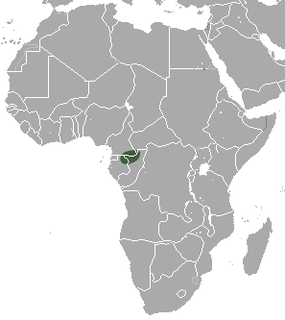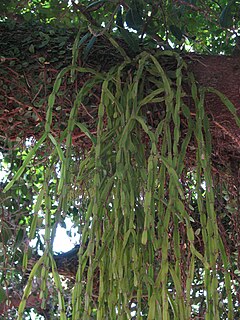
The African spurred tortoise, also called the sulcata tortoise, is a species of tortoise inhabiting the southern edge of the Sahara desert in Africa. It is the third-largest species of tortoise in the world, the largest species of mainland tortoise, and the only extant species in the genus Centrochelys.

Rhipsalis baccifera, commonly known as the mistletoe cactus, is an epiphytic cactus which originates from Central and South America, the Caribbean, and Florida. It is also found throughout the tropics of Africa and into Sri Lanka where it is known in Sinhala as nawahandi (නවහන්දි). This is the only cactus species naturally occurring outside the Americas. One hypothesis is that it was introduced to the Old World by migratory birds, long enough ago for the Old World populations to be regarded as distinct subspecies. An alternative hypothesis holds that the species initially crossed the Atlantic Ocean on European ships trading between South America and Africa, after which birds may have spread it more widely.

Callitris sulcata is a species of conifer in the cypress family, Cupressaceae. Its common name is Sapin de Comboui. It is endemic to New Caledonia, where it grows only in three forested river valleys. It is an endangered species with a global population of no more than 2500 individuals.

Flower's shrew is a species of mammal in the family Soricidae. It is endemic to Egypt. Its natural habitat is arable land. It is threatened by habitat loss.

The Usambara shrew is a species of mammal in the family Soricidae. It is endemic to Tanzania. Its natural habitat is subtropical or tropical moist montane forests. It is threatened by habitat loss.

Remy's pygmy shrew is a species of mammal in the family Soricidae. It is found in Cameroon, the Central African Republic, the Republic of the Congo, and Gabon. Its natural habitat is subtropical or tropical moist lowland forests. It is threatened by habitat loss.

Johnston's forest shrew is a species of mammal in the family Soricidae found in Burundi, Cameroon, the Central African Republic, the Republic of the Congo, the Democratic Republic of the Congo, Equatorial Guinea, Gabon, Rwanda, Tanzania, and Uganda. Its natural habitats are subtropical or tropical moist lowland forest and subtropical or tropical moist montane forest. It is threatened by habitat loss.
Newcombia sulcata is a species of tropical tree-living air-breathing land snail, arboreal pulmonate gastropod mollusk in the family Achatinellidae. This species is endemic to the United States.
Hopea sulcata is a species of plant in the family Dipterocarpaceae. It is a tree endemic to Peninsular Malaysia.
Rhipsalis cereoides is a species of plant in the family Cactaceae. It is endemic to Brazil. Its natural habitats are subtropical or tropical moist lowland forests and rocky areas. It is threatened by habitat loss.

Rhipsalis crispata is a species of terrestrial plant in the family Cactaceae.

Rhipsalis elliptica is a species of plant in the family Cactaceae. It is endemic to Brazil. Its natural habitat is subtropical or tropical moist lowland forest. It is threatened by habitat loss.

Rhipsalis floccosa is a species of plant in the family Cactaceae. It is found in Argentina, Bolivia, Brazil, Paraguay, Peru, and Venezuela. Its natural habitat is subtropical or tropical moist lowland forest. It is threatened by habitat loss.

Rhipsalis hoelleri is a species of plant in the family Cactaceae. It is endemic to Brazil. Its natural habitat is subtropical or tropical moist lowland forests. It is threatened by habitat loss.

Rhipsalis oblonga is a species of plant in the family Cactaceae. It is endemic to Brazil. Its natural habitat is subtropical or tropical moist lowland forests. It is threatened by habitat loss.
Rhipsalis pacheco-leonis is a species of plant in the family Cactaceae. It is endemic to Brazil. Its natural habitats are subtropical or tropical moist lowland forests and rocky areas. It is threatened by habitat loss. It needs water and sunlight.

Rhipsalis paradoxa is a species of plant in the family Cactaceae. It is endemic to Brazil. Its natural habitat is subtropical or tropical moist lowland forests. It is threatened by habitat loss.

Rhipsalis pilocarpa, the hairy-fruited wickerware cactus, is a species of flowering plant in the cactus family that is endemic to Brazil. Scarce in the wild, it is known only in a small number of isolated locations. Its status is listed as “vulnerable” by the IUCN Red List. However, it is cultivated as an ornamental houseplant and as such has gained the Royal Horticultural Society’s Award of Garden Merit.

Rhipsalis russellii is a species of plant in the family Cactaceae. It is endemic to Brazil. Its natural habitats are subtropical or tropical moist lowland forests and rocky areas. It is threatened by habitat loss.

Rhipsalis mesembryanthemoides is a cactus in the genus Rhipsalis of the family Cactaceae. The first description was in 1821 by Adrian Hardy Haworth. The shoots are reminiscent of the plants of the genus Mesembryanthemum, hence the epithet mesembryanthemoides.

















